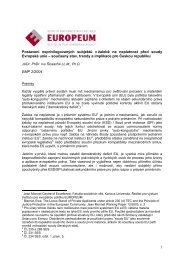eu constitutionalisation - EUROPEUM Institute for European Policy
eu constitutionalisation - EUROPEUM Institute for European Policy
eu constitutionalisation - EUROPEUM Institute for European Policy
You also want an ePaper? Increase the reach of your titles
YUMPU automatically turns print PDFs into web optimized ePapers that Google loves.
Chapter 1: Constitutionalisation: the Case of the Convention as a Network Analysis“<strong>Policy</strong> communities” posed structural elements; “issue networks” createdthe sources of dynamics.<strong>Policy</strong> communitiesPresidiumRepresentatives of the governmentsRepresentatives of the national parliamentsMembers of the <strong>European</strong> ParliamentMembers of the CommissionRepresentatives of PPERepresentatives of PESetc.30Issue networksLike minded countries groupFrench-German ‘axis’British-Spanish cooperation (Iraq war)Spanish-Polish cooperation (QMV)etc.Different theories used <strong>for</strong> an explanation of the <strong>constitutionalisation</strong> processin the EU as well as <strong>European</strong> integration as such can coexist. Evidencecan be found to either validate or invalidate each one.³⁴ They represent thetools <strong>for</strong> understanding different slices of the EU studies cake.³⁵Bargaining or deliberation?The integration process and the interaction among many actors attemptto reach a consensus. Two ways are mentioned: bargaining and deliberation.The network analysis is mentioned as a useful tool <strong>for</strong> understandingbargain theories. In the case of the Convention, the question arises if wecan use the bargain theory or the deliberation theory <strong>for</strong> the work andposition claiming and the results. Lucie Königová and Petr Kratochvíl, ofthe <strong>Institute</strong> of International Relations in Prague, explain the method ofthe Convention, and compare it with the method of IGC and through theperspective of the theory of negotiation, the perceive the process from twodifferent points of view – using in fact two grand theories:³⁶Conflict of national interestsIGC negotiations are the conflicts of thegovernments with clearly <strong>for</strong>mulated positions.Proximity of agents (some actors have strongerposition and are directing the agenda anddirecting the discussion).34) LANDFRIED (2004)35) ROSAMOND (2000), p. 112-11336) KÖNIGOVÁ and KRATOCHVÍL (2004)Common search <strong>for</strong> <strong>European</strong> interestNegotiations are an argumentation and persuasionprocess, the preferences of actors can change duringthe negotiation.Proximity of actors (identical possibility to initiatethe negotiation, ask question and open the debate).Chapter 1: Constitutionalisation: the Case of the Convention as a Network AnalysisThis approach, encompassing the federal and intergovernmental perspectives,leads to simplification of a very complex process of <strong>European</strong> governanceand consensus seeking.Applying multi-level governance theory is then omitting the zero–sumnegotiations associated with the intergovernmental approach and seeingthe EU negotiations according to Andrew Moravcsik’s <strong>for</strong>mula: “nationalinterests → state preferences → international negotiations → outcome”.³⁷The paper does not support Moravcsik’s statement that: “<strong>European</strong>integration can best be explained as a series of rational choices made bynational leaders”.³⁸ The method of bargaining could be applied only atcertain specific cases in the Convention, e.g. when Britain was statingits “red lines”. For majority cases I consider more suitable the methodof deliberation.³⁹ Francesco Marchi (in this volume) argues that highsaliency issues such as the power structure and institutional architectureof the EU, the definition of the budget, economic coordination, therein<strong>for</strong>ced cooperation, the revision procedure of the treaty and thecommon <strong>for</strong>eign policy were negotiated by hard-style ‘horse trading’bargaining and amidst asymmetrical power relations. On the other handlow saliency and high technicality issues such as regulatory or juridicalissues attracted more actors with high technical knowledge and juridicalknowledge and were characterized by the deliberative style of discussionwith symmetrical relation of power.⁴⁰ Manja Klemenčič (also in thisvolume) proposes to use coalition-building behaviour <strong>for</strong> an explanation<strong>for</strong> the case of the Convention⁴¹.The Convention in its 18 months of duration represented a very livelyorganism, where numerous different interests were <strong>for</strong>mulated andexpressed. As stated above, the case of the Convention can be conceived37) MORAVCSIK (1998), p. 23, see also DEHOUSSE (1997), p. 3738) MORAVCSIK (1998), p.1839) “The analytical [and normative] distinction between the deliberative and bargaining modes of conflict– resolution has become very fashionable in political science in the last ten years. Very schematically,this distinction can be summarized in these terms”i) bargaining is usually defined, in the widely accepted terms of social choice theory, as a process between a]actors with stable preferences, b] who try to maximize their benefits, c] through exchanges of concessions.ii) by contrast, the advocates of deliberation argue that this process takes place among a] actors whoare ready to change their preferences, b] when they are convinced by rational arguments, c] in order toreach ‘common goods’. MAGNETTE (2003), p. 2840) MARCHI (2005), p. 841) KLEMENČIČ (2005)31








